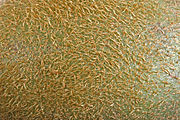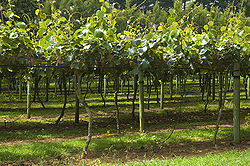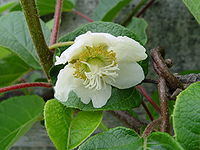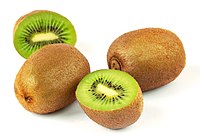The kiwifruit (or kiwi) is the edible berry of a cultivar group of the woody vine Actinidia deliciosa and hybrids between this and other species in the genus Actinidia. The Actinidia is native to China.
The most common cultivars of kiwifruit are oval, about the size of a large hen's egg (5–8 cm / 2–3 in long and 4.5–5.5 cm / 1¾–2 in diameter). It has a fibrous, dull brown-green skin and bright green or golden flesh with rows of small, black, edible seeds. The fruit has a soft texture and a unique flavour, and today is a commercial crop in several countries.
Originally known as the Chinese Gooseberry[1], the fruit was renamed for export marketing reasons in the 1950s; briefly to melonette, and then by New Zealand exporters to kiwifruit. This latter name comes from the kiwi — a flightless bird and New Zealand's national symbol, and also a colloquial name for the New Zealand people.
To avoid confusion with the bird and the people, the fruit is always called "kiwifruit" in New Zealand and Australia. However, in other countries it is sometimes abbreviated to "kiwi".
History
Actinidia deliciosa is native to southern China, where it is declared as the "National Fruit" of the People's Republic of China.[2] Other species of Actinidia are also found in India and Japan and north into southeastern Siberia. Cultivation spread from China in the early 20th century, when seeds were introduced to New Zealand by Mary Isabel Fraser, the principal of Wanganui Girls' College, who had been visiting mission schools in Yichang, China.[3] The seeds were planted in 1906 by a Wanganui nurseryman, Alexander Allison, with the vines first fruiting in 1910.
The familiar cultivar Actinidia deliciosa 'Hayward' was developed by Hayward Wright in Avondale, New Zealand around 1924. It was initially grown in domestic gardens, but commercial planting began in the 1940s. Italy is now the leading producer of kiwifruit in the world, followed by China, New Zealand, Chile, France, Greece, Japan and the United States. In China, kiwifruit was traditionally collected from the wild, but until recently China was not a major producing country.[4] In China, it is grown mainly in the mountainous area upstream of the Yangtze River. It is also grown in other areas of China, including Sichuan.[5] The hairs on the skin of the kiwi fruit are used in the Far East as a treatment for baldness. Western medicine has not confirmed this claim, and unlike some functional foods, the United States Food and Drug Administration has not granted this belief the status of "scientific agreement".
Cultivars
Almost all kiwifruit in commerce belong to a few cultivars of Actinidia deliciosa: 'Hayward', 'Chico', and 'Saanichton 12'. The fruit of these cultivars are practically indistinguishable from each other and match the description of a standard kiwifruit given at the head of this article.
Gold Kiwifruit or "Hinabelle", with yellow flesh and a sweeter, less acidic flavour resembling a tropical fruit salad, is a new Cultivar Group produced by the New Zealand Crown Research Institute, HortResearch and marketed worldwide in increasing volumes. Some wild vines in India have yellow fruit but are small and not commercially viable. Seeds from these plants were imported to New Zealand in 1987 and the company took 11 years to develop the new fruit through cross-pollination and grafting with green kiwi vines. Gold Kiwifruit have a smooth, bronze skin, a pointed cap at one end and distinctive golden yellow flesh with a less tart and more tropical flavour than green kiwifruit. It has a higher market price than green kiwifruit. It is less hairy than the green cultivars, so can be eaten whole after rubbing off the thin, fluffy coat.
Nutrition
Kiwifruit is a rich source of vitamin C, 1.5 times the DRI scale in the US. Its potassium content by weight is slightly less than that of a banana. It also contains vitamins A and E. The skin is a good source of flavonoid antioxidants. The kiwifruit seed oil contains on average 62% alpha-linolenic acid, an omega-3 fatty acid.[6] Usually a medium size kiwifruit contains about 46 calories[7], 0.3 g fats, 1 g proteins, 11 g carbohydrates, 75 mg vitamins and 2.6 g dietary fiber.
Kiwifruit is often reported to have mild laxative effects, possibly because of the high level of dietary fiber.[8]
Raw kiwifruit is also rich in the protein-dissolving enzyme actinidin, (in the same family of thiol proteases as papain), which is commercially useful as a meat tenderizer but can be an allergen for some individuals. Specifically, people allergic to latex, papayas or pineapples are likely to be allergic to kiwifruit also. Reactions include sweating, tingling and sore mouth; swelling of the lips, tongue and face; rash; vomiting and abdominal pain; and, in the most severe cases, breathing difficulties, wheezing and collapse. The most common symptoms are unpleasant itching and soreness of the mouth, with the most common severe symptom being wheezing. Severe symptoms are most likely to occur in young children.
This enzyme makes raw kiwifruit unsuitable for use in desserts containing milk or any other dairy products which are not going to be served within hours, because it soon begins to digest milk proteins. This applies to gelatin-based desserts as well, as the actinidin will dissolve the collagen proteins in gelatin very quickly, either liquifying the dessert, or preventing it from solidifying. However, the U.S. Department of Agriculture suggests that cooking the fruit for a few minutes before adding it to the gelatin will overcome this effect.[9] Sliced kiwifruit has long been regularly used as a garnish atop whipped cream New Zealand's national dessert, the pavlova.
Kiwifruit also serves as a natural blood thinner. A recent study performed at the University of Oslo in Norway reveals that--similar to popular mainstream aspirin therapy-consuming two to three kiwifruit daily for 28 days significantly thins the blood, reducing the risk of clots, and lowers fat in the blood that can cause blockages.[10]
Cultivation
| 0.48 | |
| 0.28 | |
| 0.15 | |
| 0.08 | |
| 0.04 | |
| 0.04 | |
| 0.02 | |
| 0.02 | |
| 0.01 | |
| 0.01 | |
| World Total | 1.14 |
| Source: UN Food and Agriculture Organization (FAO)[1] | |
Kiwifruit can be grown in most temperate climates with adequate summer heat. Where Actinidia deliciosa is not hardy, other species can be grown as substitutes.
Kiwifruit is commercially grown on sturdy support structures, as it can produce several tonnes per hectare, more than the rather weak vines can support. These are generally equipped with a watering system for irrigation and frost protection in the spring.
Kiwifruit vines require vigorous pruning, similar to that of grapevines. Fruit is borne on one-year-old and older canes, but production declines as each cane ages. Canes should be pruned off and replaced after their third year.
Kiwifruit plants are normally dioecious, meaning that individual plants are male or female. Only female plants bear fruit, and only when pollenized by a male plant. One male pollenizer is required for each three to eight female vines. An exception is the cultivar 'Issai', a hybrid (Actinidia arguta x polygama) from Japan, which produces perfect flowers and can self-pollinate; unfortunately it lacks vigour, is less hardy than most A. arguta forms and is not a large producer.
Kiwifruit is notoriously difficult to pollinate because the flowers are not very attractive to bees. Some producers blow collected pollen over the female flowers. But generally the most successful approach is saturation pollination, where the bee populations are made so large (by placing hives in the orchards) that bees are forced to use this flower because of intense competition for all flowers within flight distance.
Gallery
| Kiwifruit farm in Himachal Pradesh, India | |||










Tidak ada komentar:
Posting Komentar